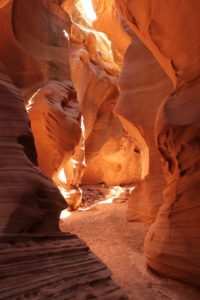 I can see the craters of the moon from my sleeping bag. The gentle gray pockmarks cast shadows upon the otherwise iridescent crescent, as if river rock strewn across a sandy bank. Below, the silhouette of the high canyon walls tower, their black rock contrasting with the black of the night sky. And all that lies within the canyon wash beneath disappears into nothingness – not to be seen until morning, when an ember from the sun sheds her Eastern light. As I write this, cocooned in my sleeping bag and fighting sleep, a light desert zephyr wanders through the cottonwood leaves, as if the night itself were sighing.
I can see the craters of the moon from my sleeping bag. The gentle gray pockmarks cast shadows upon the otherwise iridescent crescent, as if river rock strewn across a sandy bank. Below, the silhouette of the high canyon walls tower, their black rock contrasting with the black of the night sky. And all that lies within the canyon wash beneath disappears into nothingness – not to be seen until morning, when an ember from the sun sheds her Eastern light. As I write this, cocooned in my sleeping bag and fighting sleep, a light desert zephyr wanders through the cottonwood leaves, as if the night itself were sighing.
The beauty in canyon country is apparent. In fact, it has become commonplace for my peers and I to exclaim over the apparent gifts of the desert almost hourly. Perhaps one moment over the startling azure sky accentuated by the blood red of the Wingate Sandstone, or the next over the modest desert primrose, which blooms clean amidst the desert, dust. On some days, even the humble hues of lichen can catch our eyes, and we revel in the fact that this life form has budded in the seemingly bleakest of places.
And yet, beauty is often just a visual. While yes, admittedly it can spark wonder, inspire action, and foster reflection; it nonetheless acts as a veil. A veil draped most delicately over a complex natural system infused with nuance. And it is not until we lift this veil and learn the stories of geologic time, evolution and adaptation, and human culture that we truly sees the beauty that graces this labyrinth.
The low morning sun licked the western walls in light. Rising early, we bushwhacked our way through a forest of rabbitbrush and willow before greeting the river and waking our tired bodies by wading across. Approaching the opposite bank we could see a flat layer coated with low-lying vegetation, and littered with eroded remnants of rock fallen from the Chinle Formation. As we approached these boulders our anticipation grew. Grew, for we knew what was lying hidden – Grallator tracks dating from the late Triassic Period more than 208 million years ago.
As my fingers lingered upon a fallen table of rock, my eyes scanning the surface for signs of a bipedal therapod, I heard Lindsey shout. She had found the footprints encased by time. Rushing over to join, I was stunned to find what must have been 100 plus superimposed prints perfectly preserved in this layer of rock. We spent the morning with the tracks, gleaning together pieces of information so that we could paint a picture of the Grallators – answering questions such as what environment they inhabited, how many travelled through this site, and what they may have been doing when these tracks were made. By noon, we parted ways to create more footprints of our own.
Our backpacking, bushwhacking, river-crossings, and exclamations over vistas have been supplemented by moments like these, and with readings that help explain the natural history of this area. For it is only in seeing Grallator tracks, and entire logs of petrified wood in the Chinle formation, and in knowing the Navajo sandstone once comprised the largest sand dune desert in Earth’s history, that one can see past the veil and understand the complete beauty of a place.
What is more, is through this heightened understanding of our surroundings, not only do we gain, but the Earth gains as well. For in taking note of natural history, we pay respect to the natural world. In the words of Thomas Fleishner, “When we pay respectful attention to the living world, thus getting to know it, the world is served in the pragmatic and limited world of human politics – for a known and loved world has more effective advocates than one that’s ignored.”
And so, we WRFI students have worked to supplement our travels with a more intimate understanding of the landscape, and of those who have traveled through these canyons before us. In doing so not only we do see the complete beauty around us, but we give back to this land with our humble offerings of awareness. We seek to see beyond the veil.
One Reply to “Mary Loomis: Craters of the Moon”
Comments are closed.
There certainly is no other experience like the WRFI experience and seeing the land for every little marvel that it is. Thank you for such a lovely, well-written post – brightened my day.